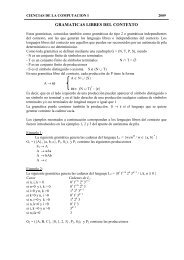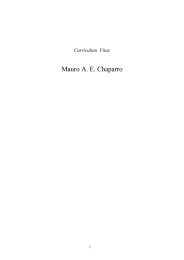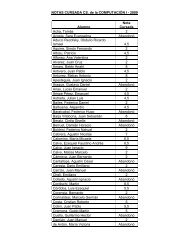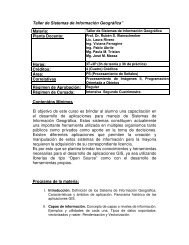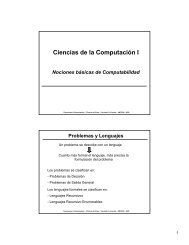Libro de Resúmenes / Book of Abstracts (Español/English)
Libro de Resúmenes / Book of Abstracts (Español/English)
Libro de Resúmenes / Book of Abstracts (Español/English)
Create successful ePaper yourself
Turn your PDF publications into a flip-book with our unique Google optimized e-Paper software.
Resumenes 84<br />
⎧dx<br />
⎛ x ⎞ qx<br />
⎪ = r⎜1<br />
− ⎟(<br />
x − m)<br />
x − y<br />
⎪ dt ⎝ K ⎠ x + a<br />
⎪<br />
X µ : ⎨<br />
⎪<br />
⎪dy<br />
⎛ y ⎞<br />
= s<br />
⎪ ⎜<br />
⎜1−<br />
⎟ y<br />
⎩ dt ⎝ n x ⎠<br />
7<br />
where ( , , , , , , ) + ℜ ∈<br />
= n s a b q K r µ and the parameters have different biological<br />
meanings. By means <strong>of</strong> a diffeomorphism (Chicone 1999, Guckenheimer<br />
and Holmes 1983), we make the study in the topologically equivalent<br />
system given by:<br />
⎧du<br />
2<br />
⎪ = ( ( 1−<br />
u)(<br />
u − M )( u + A)<br />
− v)<br />
u<br />
dτ<br />
⎪<br />
Yη<br />
: ⎨<br />
⎪ dv<br />
⎪ = B(<br />
u − v)(<br />
u + A)<br />
v<br />
⎩dτ<br />
We prove that the Allee effect produces a great modification in the behavior<br />
<strong>of</strong> May-Holling-Tanner mo<strong>de</strong>l, analysed in (Sáez and González-Olivares<br />
1999), where it was <strong>de</strong>monstrated the existence <strong>of</strong> two limit cycles<br />
surrounding the unique equilibrium point at the interior <strong>of</strong> the first<br />
quadrant, for a set <strong>of</strong> parameter values, showing that local stability does<br />
not imply global stability <strong>of</strong> the equilibrium point.<br />
In the mo<strong>de</strong>l studied here varied dynamics appear that are not<br />
topologically equivalent to the original one, for some we give the respective<br />
ecological interpretation. Among other results we have that:<br />
1. For any parameter values the singularity (0, 0) is a non-hyperbolic<br />
attractor (Chicone 1999, Guckenheimer and Holmes 1983), and (1,0) is an<br />
hyperbolic saddle point.<br />
2. There exists a set <strong>of</strong> parameter for which two equilibrium point in the<br />
interior <strong>of</strong> the first quadrant exists; also an unique or one having multiplicity<br />
two can exist.<br />
3. When we have an unique positive equilibrium point <strong>of</strong> multiplicity two, it<br />
occurs the codimension 2 saddle-no<strong>de</strong> bifurcation (Chicone 1999).<br />
4. When two positive equilibrium points exist one <strong>of</strong> them is always a<br />
hyperbolic saddle point and the nature <strong>of</strong> the other <strong>de</strong>pends on sign <strong>of</strong><br />
trace; in this case there exists an unique limit cycle obtained via Hopf<br />
bifurcation.<br />
System Yn is highly sensitive to initial conditions and as the origin is<br />
always an attractor the possibility <strong>of</strong> extinction <strong>of</strong> both populations is large<br />
<strong>de</strong>pending mainly on the predator-prey ratio.<br />
Referencias<br />
[1] Arrowsmith, D. K., Place, C. M. 1992. Dynamical System. Differential<br />
equations, maps and chaotic behaviour. Chapman and Hall.<br />
[2] Chicone C. 1999. Ordinary differential equations with applications, Text in<br />
Applied Mathematics 34, Springer.<br />
[3] Clark, C. W. 1990. Mathematical Bioeconomic: The optimal management <strong>of</strong><br />
renewable resources, (second edition). John Wiley and Sons.


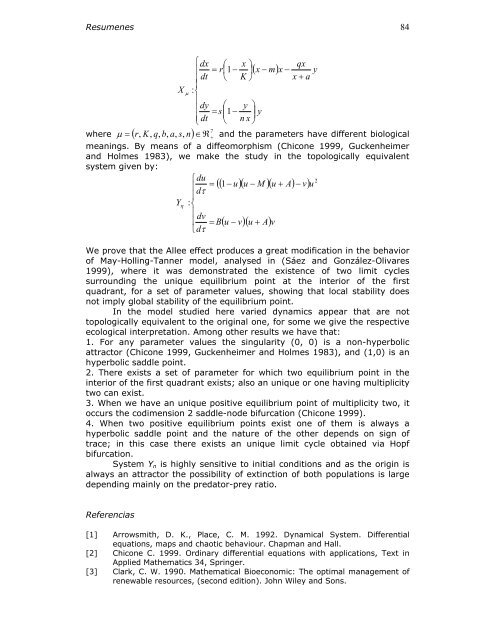
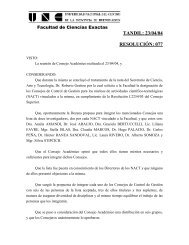
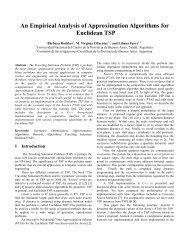
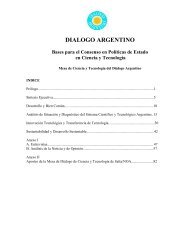


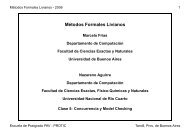
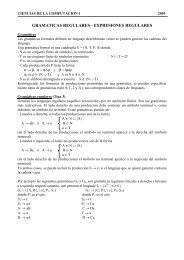

![Clase 13 [pdf]](https://img.yumpu.com/19616969/1/190x245/clase-13-pdf.jpg?quality=85)

